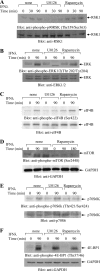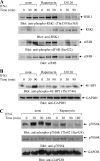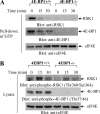Regulatory effects of ribosomal S6 kinase 1 (RSK1) in IFNλ signaling
- PMID: 21075852
- PMCID: PMC3020721
- DOI: 10.1074/jbc.M110.183566
Regulatory effects of ribosomal S6 kinase 1 (RSK1) in IFNλ signaling
Abstract
Although the mechanisms of generation of signals that control transcriptional activation of Type III IFN (IFNλ)-regulated genes have been identified, very little is known about the mechanisms by which the IFNλ receptor generates signals for mRNA translation of IFNλ-activated genes. We provide evidence that IFNλ activates the p90 ribosomal protein S6 kinase 1 (RSK1) and its downstream effector, initiation factor eIF4B. Prior to its engagement by the IFNλ receptor, the non-active form of RSK1 is present in a complex with the translational repressor 4E-BP1 in IFNλ-sensitive cells. IFNλ-inducible phosphorylation/activation of RSK1 results in its dissociation from 4E-BP1 at the same time that 4E-BP1 dissociates from eIF4E to allow formation of eIF4F and initiation of cap-dependent translation. Our studies demonstrate that such IFNλ-dependent engagement of RSK1 is essential for up-regulation of p21(WAF1/CIP1) expression, suggesting a mechanism for generation of growth-inhibitory responses. Altogether, our data provide evidence for a critical role for the activated RSK1 in IFNλ signaling.
Figures







Similar articles
-
Activation of the p70 S6 kinase and phosphorylation of the 4E-BP1 repressor of mRNA translation by type I interferons.J Biol Chem. 2003 Jul 25;278(30):27772-80. doi: 10.1074/jbc.M301364200. Epub 2003 May 20. J Biol Chem. 2003. PMID: 12759354
-
Regulatory effects of SKAR in interferon α signaling and its role in the generation of type I IFN responses.Proc Natl Acad Sci U S A. 2014 Aug 5;111(31):11377-82. doi: 10.1073/pnas.1405250111. Epub 2014 Jul 21. Proc Natl Acad Sci U S A. 2014. PMID: 25049393 Free PMC article.
-
Inhibition of phosphatidylinositol 3-kinase- and ERK MAPK-regulated protein synthesis reveals the pro-apoptotic properties of CD40 ligation in carcinoma cells.J Biol Chem. 2004 Jan 9;279(2):1010-9. doi: 10.1074/jbc.M303820200. Epub 2003 Oct 27. J Biol Chem. 2004. PMID: 14581487
-
4E-BP1, a multifactor regulated multifunctional protein.Cell Cycle. 2016;15(6):781-6. doi: 10.1080/15384101.2016.1151581. Cell Cycle. 2016. PMID: 26901143 Free PMC article. Review.
-
The RSK factors of activating the Ras/MAPK signaling cascade.Front Biosci. 2008 May 1;13:4258-75. doi: 10.2741/3003. Front Biosci. 2008. PMID: 18508509 Review.
Cited by
-
Regulatory effects of programmed cell death 4 (PDCD4) protein in interferon (IFN)-stimulated gene expression and generation of type I IFN responses.Mol Cell Biol. 2012 Jul;32(14):2809-22. doi: 10.1128/MCB.00310-12. Epub 2012 May 14. Mol Cell Biol. 2012. PMID: 22586265 Free PMC article.
-
IFN-λ4: the paradoxical new member of the interferon lambda family.J Interferon Cytokine Res. 2014 Nov;34(11):829-38. doi: 10.1089/jir.2013.0136. Epub 2014 Apr 30. J Interferon Cytokine Res. 2014. PMID: 24786669 Free PMC article. Review.
-
Molecular mechanisms for mitochondrial adaptation to exercise training in skeletal muscle.FASEB J. 2016 Jan;30(1):13-22. doi: 10.1096/fj.15-276337. Epub 2015 Sep 14. FASEB J. 2016. PMID: 26370848 Free PMC article. Review.
-
IFN-γ-inducible antiviral responses require ULK1-mediated activation of MLK3 and ERK5.Sci Signal. 2018 Nov 20;11(557):eaap9921. doi: 10.1126/scisignal.aap9921. Sci Signal. 2018. PMID: 30459284 Free PMC article.
-
Central Regulatory Role for SIN1 in Interferon γ (IFNγ) Signaling and Generation of Biological Responses.J Biol Chem. 2017 Mar 17;292(11):4743-4752. doi: 10.1074/jbc.M116.757666. Epub 2017 Feb 7. J Biol Chem. 2017. PMID: 28174303 Free PMC article.
References
-
- Kotenko S. V., Gallagher G., Baurin V. V., Lewis-Antes A., Shen M., Shah N. K., Langer J. A., Sheikh F., Dickensheets H., Donnelly R. P. (2003) Nat. Immunol. 4, 69–77 - PubMed
-
- Sheppard P., Kindsvogel W., Xu W., Henderson K., Schlutsmeyer S., Whitmore T. E., Kuestner R., Garrigues U., Birks C., Roraback J., Ostrander C., Dong D., Shin J., Presnell S., Fox B., Haldeman B., Cooper E., Taft D., Gilbert T., Grant F. J., Tackett M., Krivan W., McKnight G., Clegg C., Foster D., Klucher K. M. (2003) Nat. Immunol. 4, 63–68 - PubMed
-
- Kotenko S. V., Langer J. A. (2004) Int. Immunopharmacol. 4, 593–608 - PubMed
-
- Lasfar A., Lewis-Antes A., Smirnov S. V., Anantha S., Abushahba W., Tian B., Reuhl K., Dickensheets H., Sheikh F., Donnelly R. P., Raveche E., Kotenko S. V. (2006) Cancer Res. 66, 4468–4477 - PubMed
Publication types
MeSH terms
Substances
Grants and funding
LinkOut - more resources
Full Text Sources
Miscellaneous

